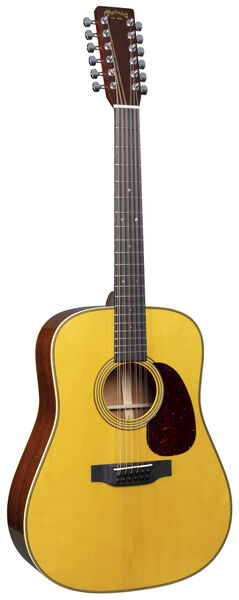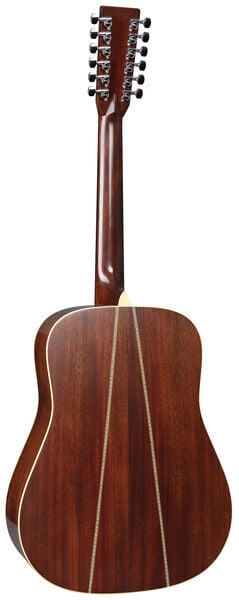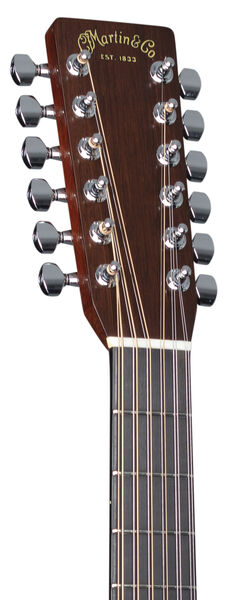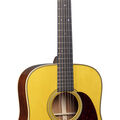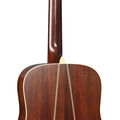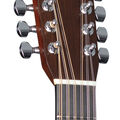D-35 David Gilmour 12 String
D-35 David Gilmour 12 String
Overview
Top
Body
Neck
Headstock
Misc
Warranty & Guides
Q&A With David Gilmour
Can you tell us a little about why you felt the timing was right to work with Martin Guitar on this custom signature artist edition?
With my old D-35 and D12-28 moving on, there was definitely a gap. These new guitars were created first and foremost as tools for me to write and record with; their specifications were chosen with no compromise. They really are what I was looking for both in their sound and in their feel. The decision to make these identical guitars available for sale came afterwards, and, of course, I hope that the project will do some good through my charitable foundation.
Many were surprised that you chose sinker mahogany, when your two “famous” Martins that went to auction were both rosewood. We’ve heard that you’re not a stranger to mahogany Martin guitars however?
That’s correct. I own a vintage D-18 from 1945 as well as a D-18 Authentic 1939. Mahogany records so very well with such clarity, so I wanted to try it with these new models, and the sinker mahogany definitely has something extra special about it.
Do you miss the guitars that were sold, or do you not really feel that way about possessions?
Not really. I hope they are giving their new owners great pleasure. It was time for them to move on. I’m very happy with the replacements.
Interesting that you chose the 1 11/16" fingerboard width, which was the standard for Martin Dreadnoughts for many decades before the recent switch to 1 3/4" for most models.
It’s just what I’m used to. The D-35 was 1 11/16". I asked Martin to create a neck shape that was more rounded than the first prototypes, that sat comfortably in my hand and was closer to the feel of my old D-18. The 1 11/16" works better with that. These amounts seem very small, but they make a huge difference.
We like your fingerboard inlay pattern. The dots seem more in proportion to those of a normal D-35.
We looked at using diamonds and squares, but I felt they looked a little small. We made them bigger, but then they looked odd, so we decided to revert to the D-35 pattern. The size of the 5th, 7th, and 9th dots on a D-35 always seemed slightly large to me, so Martin kindly shrunk them a little.
Do you play any other Martin body shapes aside from Dreadnoughts?
Yes—I have an 0-28VS. Lovely, delicate little instrument.
Do you ever play fingerstyle on a steel-strung acoustic or mainly with a pick?
I’ve done a lot of fingerpicking on steel-strung acoustic guitars over the years. Strumming with a pick, of course.
Neither your D-35 nor D12-28 had pickups, nor do your signature guitars. Do you have a preferred method/ setup for miking up and recording acoustic guitar in the studio, or does it vary?
I leave that to the professionals. They tell me that it varies, depending on the situation and location. Generally for best acoustic reproduction, the guitar is miked in a fairly standard way—in a room that is not too large or too live. Over time various Neumann, AKG, Sony, and DPA mics have been used. Internal acoustic pickups mostly are only utilised in conjunction with effects in the studio and on stage, of course.
Both the six and twelve look so classic “Golden Era” Martin and are beautifully understated/tasteful. We particularly like the vintage headstamps. Do you prefer a more straightforward look to a guitar?
I’m not keen on anything too flashy. Sound and feel are my main concerns, and I think that Martin has done a really good job with these. I like the way they look together.
Have you managed to record with the new guitars yet? Any “tunes” in them, do you think?
Yes, I have been recording at home, and the results have been pretty good. With regards to tunes... well, there’s progress, but you’ll just have to wait and see...
Martin would like to give special thanks and recognition to David’s Guitar Tech, Phil Taylor, and Westside’s Artist Relations Manager, Mark De Neys, for their invaluable contributions to this project.
